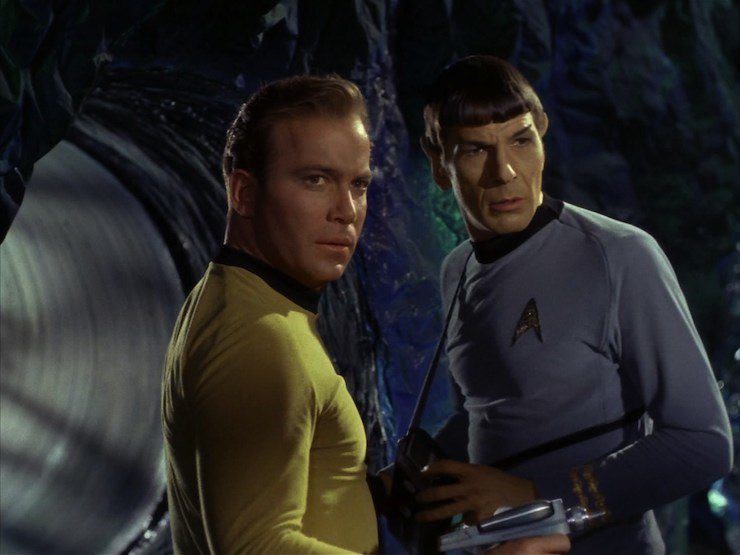Star Trek First Season
Original air dates: September 1966 – April 1967
Executive Producer: Gene Roddenberry
Producer (“Miri” forward): Gene L. Coon
Captain’s log. After a false start with “The Cage,” a more promising pilot in “Where No Man Has Gone Before,” the series settled into something like a rhythm. The Starship Enterprise travelled to the edge of the galaxy, met more than one powerful being—Charlie X and the Thasians, Trelane and his parents, the Metrons, the Organians—made a number of first contacts—the First Federation, the Gorn—and encountered more than its share of dangers—a salt vampire, a bunch of Augments, flying vomit that makes you crazy, more than one machine-run world, a disease that makes you act drunk, a malfunctioning transporter, a quasar-like phenomenon, Harry Mudd.
Throughout, they approach with the desire to, as it says in the opening credits, seek out new life and new civilizations and to find a way of solving the problems that don’t require killing. They don’t always succeed in the latter—they sometimes default to violence when it’s the wrong answer, as with the Gorn and the Klingons.
But ultimately, the hallmark of the crew is to at least try to find a solution in which people don’t die. Compassion is always the order of the day rather than violent vengeance, whether it’s against the Gorn for their seeming invasion of Cestus III or the First Federation for their threats to the Enterprise or Khan and his people for taking over the ship or Ben Finney for faking his own death and trying to ruin Kirk’s career.
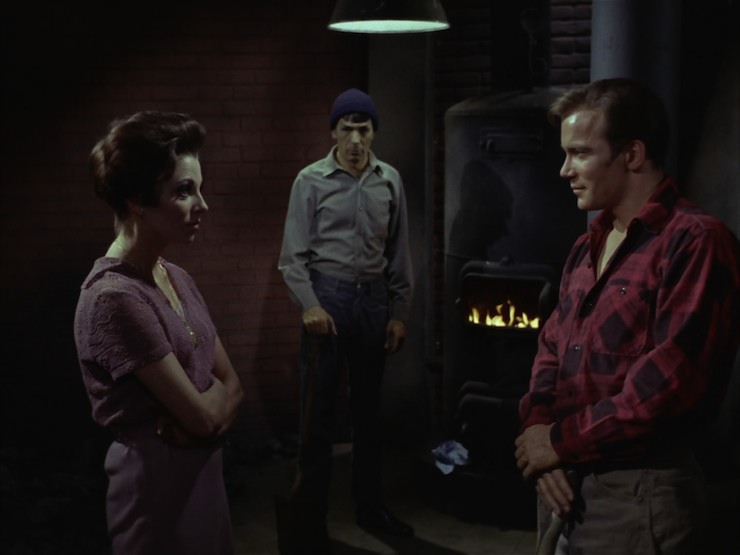
Highest-rated episode: “The City on the Edge of Forever,” the season’s only 10, and that’s kind of a “duh,” as it’s got a case for best episode of Star Trek in any of its incarnations. However, kudos to an impressive selection of 9’s: “Charlie X,” “Balance of Terror,” “Arena,” “Space Seed,” “The Devil in the Dark,” and “Errand of Mercy.”
Lowest-rated episode: A three-way tie among “Mudd’s Women,” “The Alternative Factor,” and “Operation—Annihilate!” which all received a 2.
Most comments (as of this writing): “The Cage” with 153, with honorable mention to “Where No Man Has Gone Before” (138), “The Corbomite Maneuver” (130), “Mudd’s Women” (119), “The Naked Time” (119), “Court Martial” (136), and “Space Seed” (108), all of which broke a hundred comments. This is particularly impressive given that the TNG Rewatch only broke 100 once (“Darmok”) and the DS9 Rewatch only twice (“Emissary” and “The Dogs of War”).
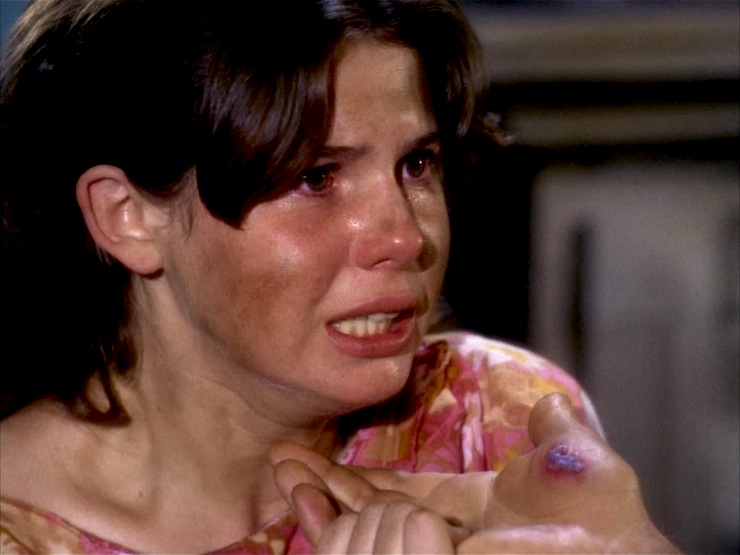
Fewest comments (as of this writing): A tie between “Miri” and “The Alternative Factor,” both with 40. By the way, I’ve been rewatching Star Trek shows since 2011 and this is my fifteenth overview of a season, and this is by far the highest number in this particular category. (The previous record for most fewest comments was 27, which was the lowest number of comments in DS9‘s first season, achieved by “The Forsaken.”)
Favorite Can’t we just reverse the polarity? From “Court Martial”: McCoy goes to a great deal of trouble to use a white-sound device (actually a microphone) to blot out the heartbeats of everyone on the bridge. Then Spock pushes three buttons to eliminate the heartbeat of the transporter chief from what they were hearing—so, uh, why couldn’t Spock just do the same thing for the bridge that he did for the transporter room????
Favorite Fascinating. From “Where No Man Has Gone Before”: Spock is firmly established as an alien, though not what species. Dehner says people from his planet don’t have feelings “like we do,” and later he himself says that he doesn’t have feelings and is only governed by logic, thus setting the tone for the character going forward. He also comes across as mostly alien, with just one human in the woodpile, referring to “an ancestor of mine” who married a human female. (This can be retconned, given that “Journey to Babel” revealed that Spock and Sarek hadn’t spoken in two decades, to Spock downplaying who it was exactly who married the human…)

Also we get more shouty Spock! During the entire trip through the galactic barrier, he bellows at the top of his lungs, calling for deflectors to be raised and for a damage report loud enough to rattle the viewscreen. My favorite, though, is the reversal of the stereotypes the characters have embodied over the years: Kirk is the calm one, quietly asking, “Any radiation, anything?” and Spock screaming, “NEGATIVE!” so loud you want to give him a valium or something.
Favorite I’m a doctor not an escalator. From “Space Seed”: McCoy’s disdain for the transporter is first seen here, as he complains that he signed on to practice medicine, not to have his atoms shot across space by “this gadget.”
He also has one of his absolute finest moments when Khan wakes up and grabs his throat while putting a scalpel to his neck. McCoy very calmly tells him to either choke him or cut his throat, and to hurry up and make up his mind. When Khan asks where he is, McCoy’s bland response is, “In bed, holding a knife to your doctor’s throat,” adding blithely that it would be more efficient to slice open the carotid artery just under the ear. Khan is impressed by his bravery, but McCoy says he was just trying to avoid an argument. And that, boys and girls, is why Leonard McCoy is the best ever.
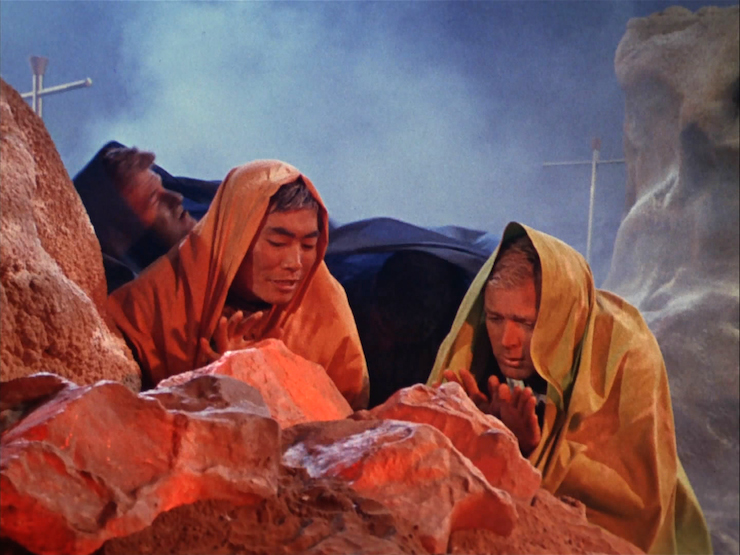
Favorite Ahead warp one, aye. From “The Enemy Within”: Sulu is in charge of the landing party and it’s to his credit that he maintains his sense of humor as long as he can (asking for coffee or rice wine to be lowered on a rope, complaining that room service is being slow, joking about skiing season, and so on), which probably helps the morale of the three guys under his command, and also reassures the folks back on the Enterprise that he’s soldiering through.
Favorite Hailing frequencies open. From “Space Seed”: Khan orders Uhura to operate the viewscreen so they can see Kirk being tortured. She refuses, so Joaquin drags her forcibly to the console. She still refuses, so Joaquin belts her. She still refuses so Joaquin moves to belt her again, and she stands up to show that it won’t work a second time either. However, McGivers stops Joaquin and operates the screen herself.
Favorite I cannot change the laws of physics! From “The Corbomite Manuever”: Scotty does absolutely nothing to justify his title of chief engineer in this episode. No, seriously, the one time he actually is doing his job as chief, he throws up his hands and says he has no frapping clue what makes the cube tick. Otherwise he just stands around and makes snotty comments about Sulu’s countdown and Spock’s parents. He does operate the transporter to beam them over to Balok’s ship, but that’s it.

Favorite Go put on a red shirt. From “The Naked Time”: Poor Joe Tormolen, done in by a badly designed environmental suit and a spectacular inability to follow proper hazmat procedure.
Favorite No sex, please, we’re Starfleet: From “Charlie X”: The mess hall scene when Uhura sings along with Spock’s Vulcan lyre playing is Exhibit B in the evidence that Roberto Orci and Alex Kurtzman did not pull the Spock-Uhura romance out of their asses for the 2009 Star Trek and Star Trek Into Darkness. I can see the pair of them rewatching the original series and getting to this scene.
KURTZMAN (not a Trek fan, pauses after Uhura’s done singing): So, those two are fucking, right?
ORCI (a longtime Trek fan): Of course not. What are you, nuts? Spock would never…
KURTZMAN: Seriously? They’re totally fucking. I mean, it’s 1966, so they can only show much, but still. Watch the scene again.
ORCI (yanks the remote out of Kurtzman’s hands and rewinds, then watches the scene again): Holy shit, they totally are!
Oh, and Charlie crushes on Rand, which is only a problem insofar as she’s an adult, he’s a teenager, and he’s all powerful.
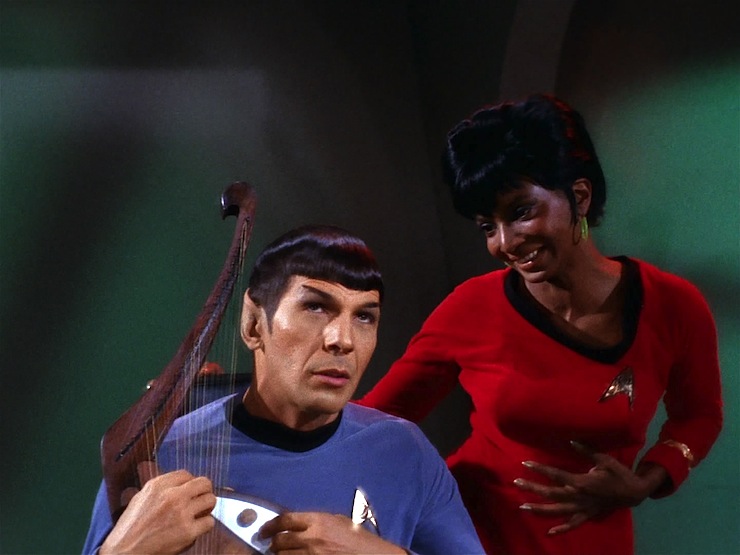
Favorite Channel open. From “The Corbomite Maneuver”: “Raising my voice back there doesn’t mean I was scared or couldn’t do my job. It means I happen to have a human thing called an adrenaline gland.”
“It does sound most inconvenient, however. Have you considered having it removed?”
“You try to cross brains with Spock, he’ll cut you to pieces every time.”
Bailey showing his lack of anatomy knowledge (it’s the adrenal gland), Spock saying “Bazinga,” and Sulu pointing out that Bailey should not go into a battle of wits unarmed.
Favorite Welcome aboard. Some of the most memorable guest stars in Trek history are in this season: Barbara Anderson as Lenore, Barbara Babcock as Mea (not to mention the voice of Trelane’s Mom), William Campbell as Trelane, Ted Cassidy as Ruk (not to mention the voices of Balok and the Gorn captain), Joan Collins as Keeler, Elisha Cook Jr. as Cogley, Kim Darby as Miri, Jill Ireland as Kalomi, Sally Kellerman as Dehner, Mark Lenard as the Romulan commander, Gary Lockwood as Mitchell, Janet MacLachlan as Masters, Arnold Moss as Karidian, Roger Perry as Christopher, Michael J. Pollard as Jahn, Malachi Throne as Mendez (not to mention the voice of the Keeper), and Robert Walker as Charlie.
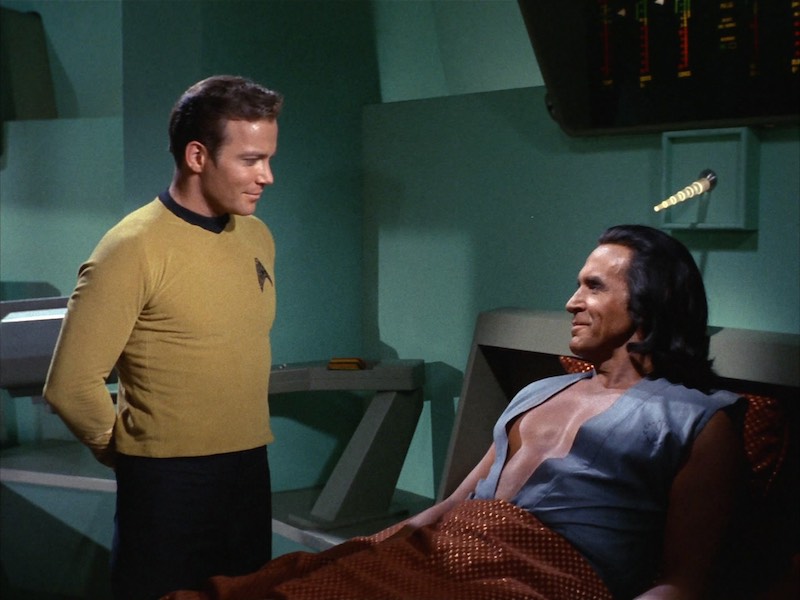
Special note must be made of Roger C. Carmel as Mudd, John Colicos as Kor, and Ricardo Montalban as Khan, all of whom were of sufficient awesomeness to be brought back (“I, Mudd,” DS9‘s “Blood Oath,” and The Wrath of Khan, respectively).
Plus recurring regulars DeForest Kelley (who’s so magnificent, he’ll be elevated to the opening credits next season), George Takei, Nichelle Nichols, James Doohan, Grace Lee Whitney, Majel Barrett, David L. Ross, Eddie Paskey, John Winston, Sean Kenney, and Michael Barrier.
But the guest that stands out the most for me is Susan Oliver in “The Cage”/”The Menagerie,” who managed the impressive task of playing, in essence, half a dozen different roles ranging from the cryptic youngest member of the Columbia survivors to the frustrated attempted girlfriend of Pike to the damsel in distress on Rigel to the headache-prone wife at the picnic to the sultry Orion dancer to her disfigured true form, and plays all of them brilliantly.
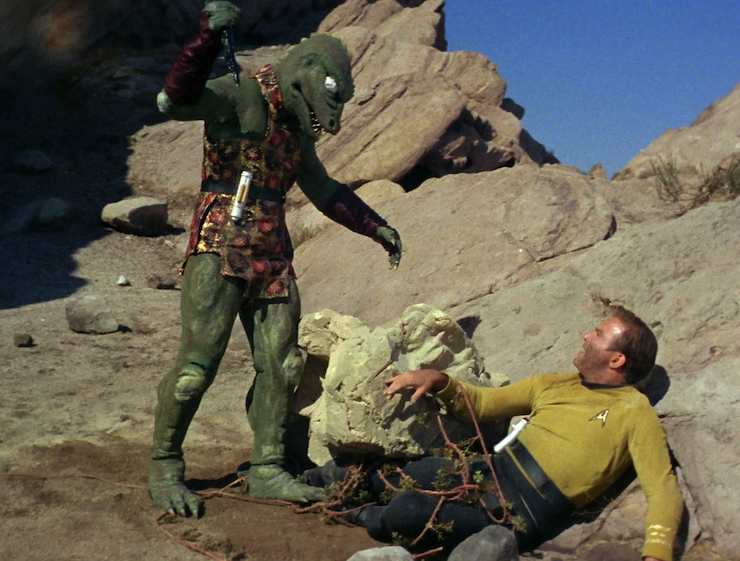
Favorite Trivial matters: Probably the one for “Arena,” given how prolific the Gorn became, how iconic the fight on Vasquez Rocks became, and how often Cestus III showed up in both DS9 and the tie-in fiction
To boldly go. “These are the voyages of the Starship Enterprise.” Watching the first season all in a row like this has been very instructive, particularly the early days (basically, before Gene Coon settled in as producer). The show kept going back and forth between a story about a community of people on a ship (“The Corbomite Maneuver,” “Charlie X”) and a show about Captain Kirk and his adventures in space along with this week’s guest star (“Dagger of the Mind,” “What Are Little Girls Made Of?”). It wasn’t until the back end of the season that it settled into the formula we all came to know and love: Kirk, Spock, and McCoy beam down to a planet and have adventures.
Which is all well and good, but I really preferred the show we got early on that built a supporting cast, and showed that these were people who’d worked together for a long time. The greater community of the Enterprise is a lot of what made episodes like “The Man Trap” and “Charlie X” and “Shore Leave” and “The Corbomite Maneuver” and even dreck like “Mudd’s Women” appealing.
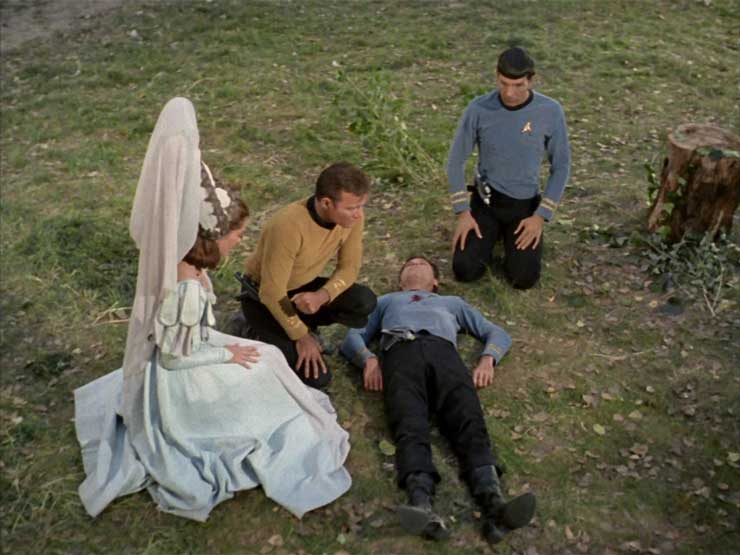
Still, that type of ensemble thinking wouldn’t really catch on in TV until decades later. What Star Trek did do that was radical for the time was an impressive selection of color-blind casting. In an era where being white was often the default, it was encouraging to see casting choices where race was irrelevant. Beyond the obvious (George Takei and Nichelle Nichols), you’ve got the characters of Stone in “Court Martial,” Boma in “The Galileo Seven,” the personnel officer in “Court Martial,” Masters in “The Alternative Factor,” and Zahra in “Operation—Annihilate!” who are all non-white characters, and their being non-Caucasian is utterly irrelevant to the character and/or storyline.
Female characters didn’t fare so well, as most of them were conceived in terms of their relationships to men, and their professional roles were secondary to their roles as women. Noel was female so they could have the awkwardness between her and Kirk regarding the Christmas party. Shaw was female because she had a past with Kirk. Masters was female because she was intended to have a relationship with Lazarus (though since they dropped that aspect, it made Masters into that rare Trek guest character who gets to be a female professional and just that). McGivers was created as a love interest for Khan, Chapel was seen only in terms of her interest in Spock and her attempt to find her lost husband, Rand was perpetually a sex object more than a character (whether to Charlie in “Charlie X,” a couple of horny crew members in “The Man Trap,” or Kirk in any number of episodes), and so on.
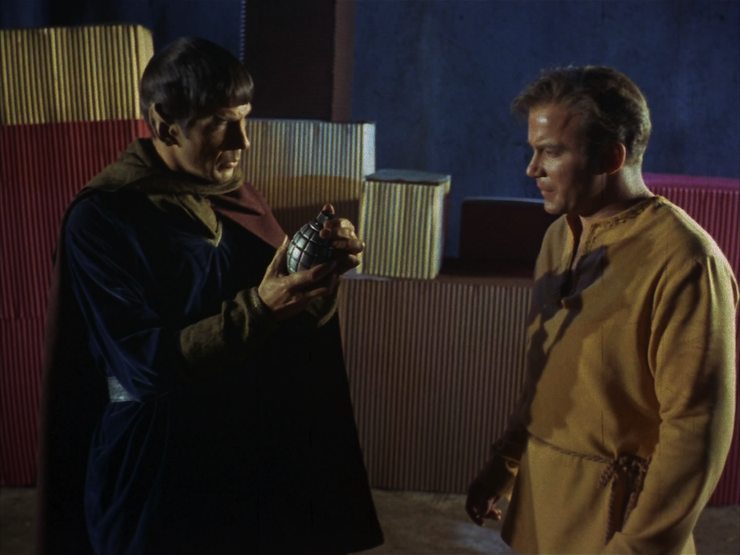
But the best thing about this season is that it showed that Trek would follow the lead of the other heavy-thinking genre shows of the era (The Twilight Zone and The Outer Limits) and try to push the boundaries of storytelling, but also to do so in a way that defaults to compassion, or at least an attempt at it, rather than cynical nastiness or a horror twist. Whether it’s pleading with the Thasians in “Charlie X” (despite everything Charlie’s done), taking the Fesarius shuttle in tow in “The Corbomite Maneuver” (despite everything Balok’s done), sparing the Gorn’s life in “Arena,” coming to an understanding with the Horta in “The Devil in the Dark,” or treating Khan with respect in “Space Seed” (despite everything he did).
Warp factor rating for the season: 8
Next week: “Catspaw”
Keith R.A. DeCandido will be at New York Comic-Con this weekend, at booth 1157 in the small press area. He’ll be sharing the booth with Megan H. Rothrock, the author of The LEGO Adventure Book series. Megan will have Volumes 1-3 of LAB on sale, and Keith will have a bunch of his books for sale, including The Klingon Art of War, his Sleepy Hollow novel Children of the Revolution, a few of his other Trek novels, his Supernatural novels Nevermore and Bone Key, and a bunch more, including his entire “Precinct” series and his new short story collection Without a License: The Fantastic Worlds of Keith R.A. DeCandido. Come on by!










